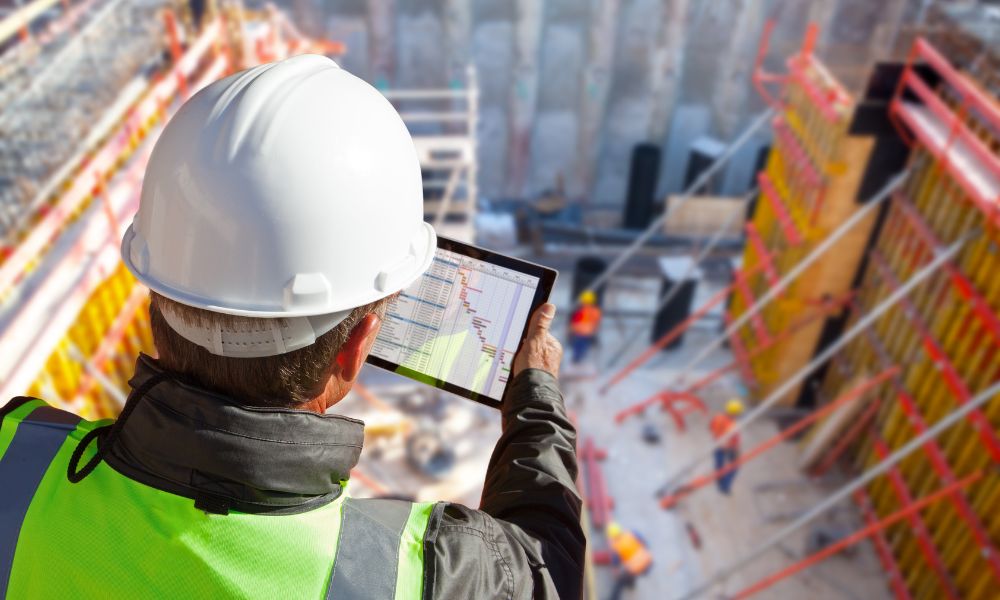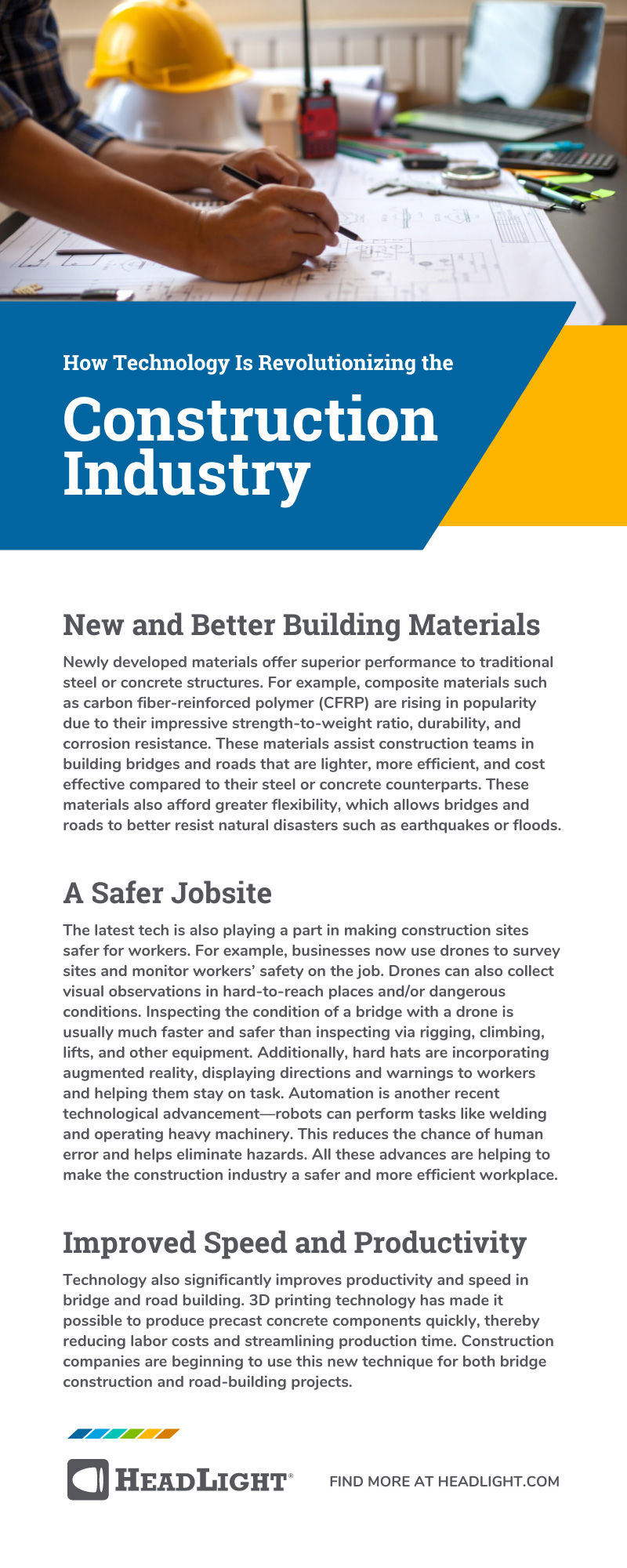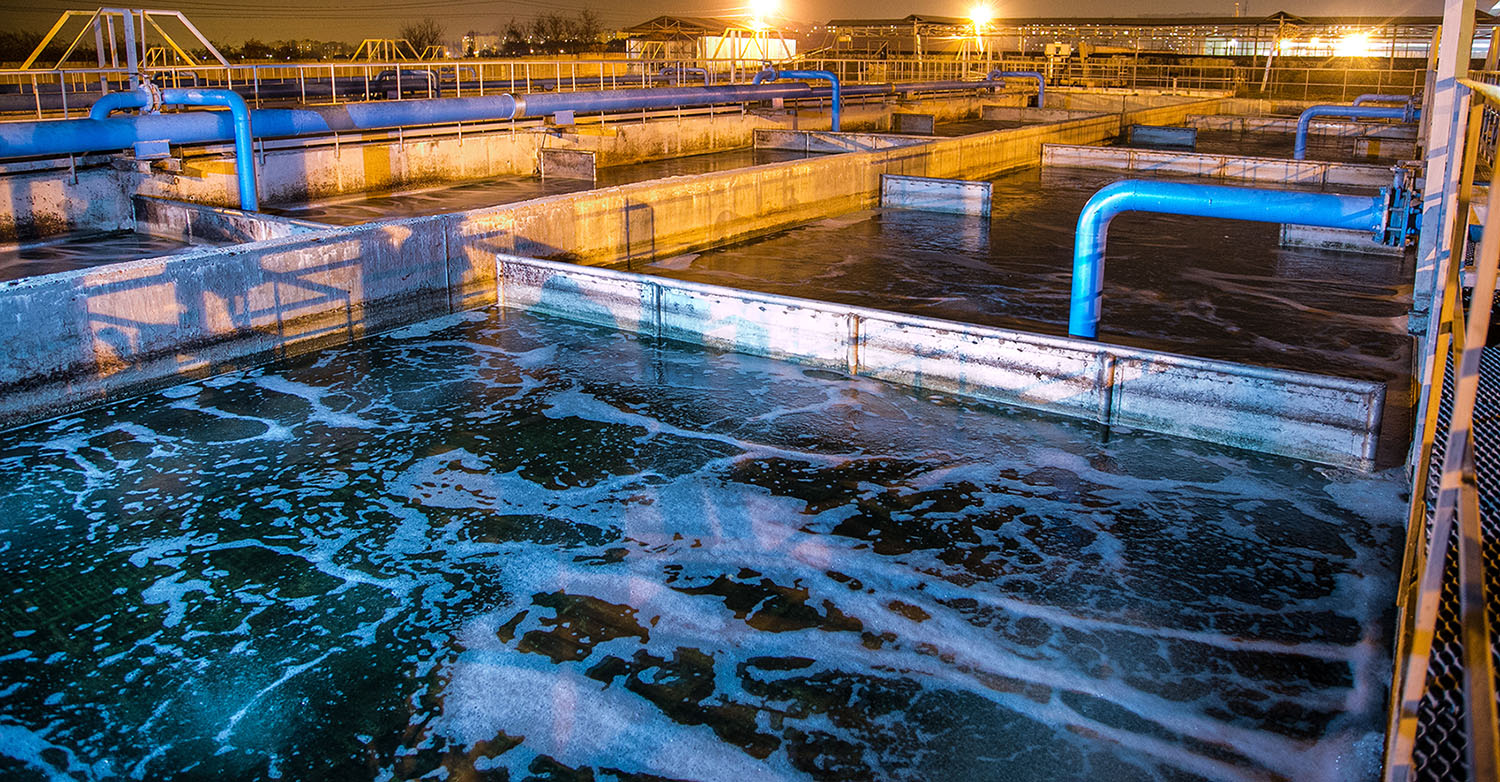
The future of construction is here and now, and it’s being revolutionized by technology. As businesses look to streamline their operations and maximize efficiency, they’re turning from traditional methods to cutting-edge tools. Engineering firms are starting to embrace building information modeling (BIM) software, while companies and DOTs deploy automated drones for site inspections. By leveraging the latest advancements in technology, businesses and owners can save time and money on their construction projects, leading to stronger bottom-line results and better outcomes for the traveling public. In this blog post, we will explore how technology is revolutionizing the construction industry, focusing on the major game-changers that have made the greatest impact so far.
New and Better Building Materials
Newly developed materials offer superior performance to traditional steel or concrete structures. For example, composite materials such as carbon fiber-reinforced polymer (CFRP) are rising in popularity due to their impressive strength-to-weight ratio, durability, and corrosion resistance. These materials assist construction teams in building bridges and roads that are lighter, more efficient, and cost effective compared to their steel or concrete counterparts. These materials also afford greater flexibility, which allows bridges and roads to better resist natural disasters such as earthquakes or floods.
Ultra-high performance concrete (UHPC) is another modern material that offers increased strength and durability for bridge and road projects. UHPC is extremely durable, making it less prone to cracking or other damage even when exposed to extreme weather conditions. This makes it ideal for structures that need to withstand regular wear and tear over time.
By using these new materials, the construction industry can build stronger and more efficient bridges and roads that will last longer and require less maintenance.
A Safer Jobsite
The latest tech is also playing a part in making construction sites safer for workers. For example, businesses now use drones to survey sites and monitor workers’ safety on the job. Drones can also collect visual observations in hard-to-reach places and/or dangerous conditions. Inspecting the condition of a bridge with a drone is usually much faster and safer than inspecting via rigging, climbing, lifts, and other equipment. Additionally, hard hats are incorporating augmented reality, displaying directions and warnings to workers and helping them stay on task. Automation is another recent technological advancement—robots can perform tasks like welding and operating heavy machinery. This reduces the chance of human error and helps eliminate hazards. All these advances are helping to make the construction industry a safer and more efficient workplace.
Improved Speed and Productivity
Technology also significantly improves productivity and speed in bridge and road building. 3D printing technology has made it possible to produce precast concrete components quickly, thereby reducing labor costs and streamlining production time. Construction companies are beginning to use this new technique for both bridge construction and road-building projects.
Similarly, the use of drones has enabled construction site inspection with greater accuracy and speed. Identifying problems sooner means less downtime and more cost savings overall. Moreover, the drone can inspect completed projects by capturing high-resolution images that provide detailed views of the finished product. Taking such images would be much more difficult without a drone.
Robotics technology is also transforming bridge and road building. Automated machines can effectively perform tasks that used to be mainly done by hand, such as welding and cutting materials. This results in enhanced accuracy and precision, along with faster construction times. Additionally, robotics technology can accurately measure complicated structures, helping engineers create designs that are both structurally sound and aesthetically pleasing.
The construction industry is benefiting from the integration of new technologies that are allowing it to work more efficiently and quickly. By using 3D printing, drones, and robotics technology, construction companies can complete bridge- and road-building projects with greater accuracy and speed.
Fewer Errors, Less Rework
The use of technology in the construction industry is also helping to reduce errors. New technologies such as digital blueprints, project management software, and 3D modeling allow for improved accuracy during construction projects, which can help save time and money. Digital blueprints enable a higher degree of accuracy when planning the layout of a project, while project management software helps to coordinate communication and scheduling of tasks between contractors, architects, and engineers. Finally, 3D modeling allows for the visualization of construction projects, allowing teams to identify potential issues or conflicts before they become costly mistakes. These tools help reduce errors in construction projects while also allowing for easier management overall.
Less Impact on the Environment
The construction industry is taking important steps toward protecting the environment. Eco-friendly bridge and road building is a major focus of many companies today as they strive to reduce the environmental impact of their projects. Technology assists these companies in protecting the planet.
In the past, construction projects used materials with higher environmental costs, such as concrete and steel. Today, there are more eco-friendly alternatives available. Innovative technologies like 3D printing allow companies to create bridges and roads with lighter materials that require less energy and fewer resources to produce. Furthermore, these materials often come from recycled or renewable sources, making them even more sustainable.
The use of technology in the construction industry is revolutionizing how companies manage and complete projects. It’s allowing for better communication between stakeholders, more efficient processes, improved safety records, and cost savings. With these changes come great opportunities for all involved in the construction industry, from project owners to engineering firms and contractors. It’s an exciting time for the construction industry, and those who have embraced technology are positioning themselves for success.
HeadLight is leading the charge in revolutionizing the construction industry with its powerful construction management software. By providing construction teams with a centralized hub for project information, HeadLight’s solutions help them stay on top of tasks and manage data across projects. Additionally, its oversight and inspection solution provides real-time access to the jobsite for all stakeholders. With this level of detail at their fingertips, all users, from the field to the office, can easily monitor and manage projects, ensuring these projects are completed on time and to the highest standards. Contact us today to learn more about how our software can benefit your business or to request a free demo.



